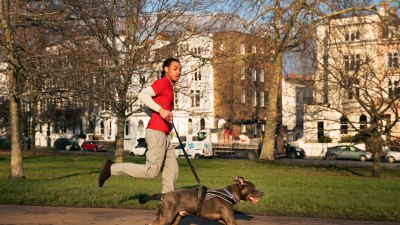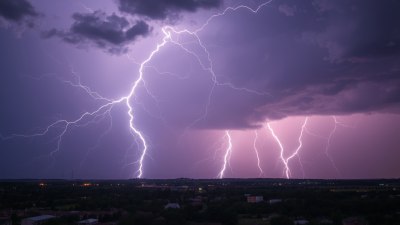Why Every Dog Walk Is Just an Improvised Weather Experiment
Explore how daily dog walks turn into spontaneous weather tests, blending pet care with unpredictable nature's elements.

Taking a dog for a walk might seem like a simple routine task, but in reality, it often turns into an unplanned weather experiment. Whether it’s a sudden downpour, an unexpected gust of wind, or rapid temperature shifts, every step outside with a furry companion is a dynamic interplay between human, dog, and the mercurial environment.
Weather is inherently unpredictable. Despite modern forecasting technology, the microclimates we encounter during a dog walk — a shady tree cover, a sunlit park patch, or a wind tunnel street — affect how both the walker and pet experience the weather's nuances. Each dog walk tests our ability to adapt, making it a live experiment in meteorological conditions.
The Unpredictability of Outdoor Conditions
The weather's unpredictable nature means that conditions during a single dog walk can change dramatically. A walk that starts under clear skies might end drenched by a sudden rainstorm. This variability forces dog owners to stay alert and ready to adjust plans or gear to protect themselves and their pets. For example, a dog wearing a light coat may suddenly require shelter when temperatures drop unexpectedly.
Urban environments amplify these fluctuations by creating microclimates. Buildings can funnel winds into narrow alleys or create shaded patches that remain cooler than surrounding areas. Unexpected heat pockets might develop on paved streets, affecting a dog’s paw comfort and willingness to walk certain routes. These localized weather effects make each walk a unique and spontaneous experiment in adapting to shifting elements.
Behavioral Responses and Weather Sensitivity
Dogs are finely attuned to their surroundings, including weather changes. Many dogs sense impending rain or storms before humans do, reacting with restlessness or reluctance to go outside. This sensitivity transforms the walk into a mutual experiment where owners observe and respond to their pet’s cues about upcoming weather shifts.
Different breeds have varied tolerances and preferences for weather conditions. Huskies thrive in cold, snowy environments and may become lethargic or overheated in warm weather. Conversely, short-nosed breeds can struggle with humidity and heat, requiring careful monitoring during walks. These breed-specific sensitivities add an additional layer of complexity to daily outings, requiring the walker to adjust timing, route, and gear accordingly.
Gear and Preparation as Experiment Variables
Equipping oneself and a pet for a walk is a form of experimentation. Using various types of dog coats, booties, umbrellas, and leashes serves to test what combinations best handle the weather conditions encountered. One day might require waterproof gear and reflective collars for a stormy twilight walk, while another needs just a simple harness and sunscreen.
Weather apps and forecasts guide preparation, yet real experience often diverges from predictions. This discrepancy turns dog walking into a hands-on test of forecast reliability and personal readiness. Adjustments made during the walk — taking detours, seeking shelter, changing pace — reflect ongoing weather experiments, where the outcome depends on observation and responsiveness.
Psychological Effects of Weather During Walks
Weather impacts not just physical comfort but mood and motivation. Grey skies and drizzle may discourage both owner and dog, reducing walk duration or enthusiasm. Conversely, bright sunny days often energize the pair, creating a more enjoyable experience. These psychological shifts turn each walk into an impromptu study of how weather influences behavior.
Owners often report feeling more connected with nature during varied weather conditions, deepening their bond with their dogs. Embracing the sensory richness of wind, rain, or heat fosters mindfulness and presence. Each walk becomes more than exercise — it is an exploratory journey into how weather colors experience and relationship.
Environmental Impact Observations
Dog walks also provide opportunities to observe the environment’s response to weather. After heavy rain, puddles form inviting playful splashes or cautionary avoidance. Frosty mornings might reveal footprints, frozen grass, or early ice formations, offering visual cues about humidity and temperature history.
Changes in weather influence local flora and fauna, visible on these walks. Frost-sensitive plants may droop after a cold snap, while budding flowers signal warming trends. Birds and insects alter activity levels based on temperature and precipitation shifts, providing spontaneous ecological lessons embedded in the daily routine.
Adapting to Seasonal Variations
Each season brings distinct weather challenges for dog walks. Winter’s cold and snow require insulated gear and shorter outings to prevent hypothermia and paw damage. Spring with its muddy trails demands cleaning routines and vigilance for allergies or ticks heightened by warm, damp conditions.
Summer heat necessitates early morning or evening walks to avoid scorching pavement and dehydration. Autumn’s changing colors come with erratic chills, wind gusts, and leaf debris, affecting footing and visibility. Successfully navigating seasonal weather is a continuous experimental process, as conditions shift year to year.
Technological Aids and Their Limitations
Smart devices now assist many dog walkers. Apps provide real-time weather alerts, UV index, pollen counts, and map routes avoiding flooded or hazardous areas. Wearable tech for dogs monitors activity and health signs, potentially influenced by weather.
However, technology cannot fully capture the nuances a walker experiences on the ground. Rain intensity and wind direction can vary block by block, making local knowledge and observation essential. Technology complements but does not replace the improvised adjustments made during walks, reinforcing the notion of dog walking as an ongoing weather experiment.
Community and Shared Experiences
Dog walking communities often share weather-related tips and anecdotal findings. Seasonal clothing suggestions, favorite sheltered routes, and tactics for adverse weather generate collective knowledge. This social exchange strengthens how individuals adapt and innovate ways to ensure walks are safe and enjoyable despite weather challenges.
Group dog walks become social experiments too, testing how different dogs and owners cope with weather changes collectively. Coordination under weather constraints teaches patience, preparedness, and cooperation among pet owners, enriching the neighborhood dynamic.
Physical Health Considerations
Weather conditions directly affect physical health during walks. Cold and wet environments can exacerbate joint problems in older dogs or cause chills in young puppies. Heat increases the risk of heatstroke and dehydration, necessitating close monitoring.
Muddy or icy paths present fall risks to both owner and dog. The experiment lies in finding optimal balance between beneficial exercise and weather-induced hazards. Adjusting walk parameters based on weather is critical for long-term health maintenance.
Urban Versus Rural Weather Experiments
Urban walks often present amplified weather challenges due to concrete heat islands, wind tunnels created by buildings, and limited green space offering shade or shelter. These factors necessitate heightened adaptability and route planning to mitigate weather discomfort for dog and owner.
Rural environments offer more varied outdoor terrain and natural shelter but introduce unpredictability like mud, insects, and uneven ground that respond dynamically to weather events. Walking in such areas demands greater preparedness for diverse weather-influenced conditions, making each outing an experimental encounter with nature’s shifts.
Educational Opportunities for Owners
Regular dog walks foster experiential learning about weather patterns and environmental science. Owners observe cause and effect — how humidity influences fog, how wind impacts temperature perception, or how changing sunlight alters mood. These lived experiments enhance appreciation for natural rhythms beyond textbook knowledge.
Moreover, teaching children or new dog owners to recognize weather signs and adjust accordingly during walks instills valuable life skills useful long past the dog walking years. This hands-on education transforms simple outdoor time into meaningful weather literacy practice.
Ecological Footprint Awareness
Dog walks also raise awareness of human impact on the environment. Weather changes amplified by climate shifts become noticeable on familiar routes. Increased flooding, extreme heat days, or erratic seasonal patterns observed during walks prompt reflection on sustainability.
Walkers often advocate for greener urban designs — more shade trees, permeable pavements, and protected habitats — inspired by firsthand weather-related discomforts or observations during dog outings. Thus, improvised weather experiments during dog walks cascade into broader conversations about environmental stewardship.
Unexpected Discoveries and Joys
Despite the challenges, the improvised nature of weather during dog walks can lead to unexpected joys. Finding a sunny patch on a chilly day, watching raindrops glisten on leaves, or feeling a refreshing breeze after heat offers spontaneous pleasures.
Dogs themselves exhibit joyful reactions to different weather conditions, from rolling in fresh snow to splashing in puddles, which can uplift their humans. This shared exploration of weather’s effects fosters a deeper connection to place, season, and animal companionship.
A Living Experiment in Patience and Flexibility
Ultimately, every dog walk is a living experiment in patience and flexibility. By navigating the variable weather, dog owners learn to expect the unexpected, develop resilience, and embrace the ever-changing outdoor environment.
This adaptability benefits not only practical walk logistics but emotional well-being, reinforcing a harmonious relationship with nature and our pets. The improvised weather experiment of a dog walk reveals how routine can surprise and educate in equal measure, turning ordinary moments into rich, interactive experiences.











